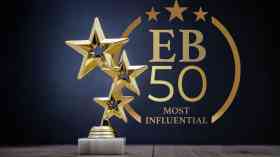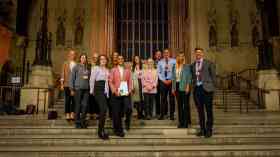Unique and inspiring
 A resurgence in Americans returning to Europe, more indigenous companies choosing to stay closer to home, and the strength of the euro against the pound and the dollar are all factors combining to inspire a renewed sense of optimism around the business tourism sector in Scotland. In addition, 2011 is a year that will see an unprecedented number of large-scale projects – both new-build and redevelopments – opening their doors to provide yet more choice for meeting planners and event organisers.
A resurgence in Americans returning to Europe, more indigenous companies choosing to stay closer to home, and the strength of the euro against the pound and the dollar are all factors combining to inspire a renewed sense of optimism around the business tourism sector in Scotland. In addition, 2011 is a year that will see an unprecedented number of large-scale projects – both new-build and redevelopments – opening their doors to provide yet more choice for meeting planners and event organisers.
All of which is all good news for a sector which, between leisure and business travellers, is a huge contributor to the Scottish economy and one of the country’s biggest employers. With almost three million business trips to Scotland in 2010, up 13 per cent on 2009, VisitScotland’s Business Tourism Unit (BTU) continues to fly the Scottish flag at home and abroad with a robust marketing programme aimed at existing and new markets.
Foreign interest
In Europe the pace of economic recovery varies from country to country, with France leading the charge and Spain yet to get off the ground. In terms of inbound business travellers to Scotland, interest from France has been gaining momentum over the past 18 months, while the BTU is noting a sudden upswing from Germany late 2010 onwards.
Enquiries continue to increase from lucrative North American markets too. Canadian visitor numbers are up 20 per cent on last year and more and more American companies are bringing incentive-based trips to Scotland to take advantage of the range of luxury venues on offer at competitive rates.
Amanda Henderson, BTU marketing manager, Europe, comments: “The wish list for European visitors is increasingly short-haul, but still with the appeal of the exotic, and obviously Scotland fits that bill in spades. France in particular is eschewing previously popular destinations in West Africa because of growing political unrest and is seeing Scotland as an undiscovered Celtic region.
“The net benefit to us is huge with French visitor numbers doubling to 44,000 from 2007 to 2009; and the value of enquiries rising from £1 milllion in business year 2009/10 to £3.6 million in 2010/11. Given results like these, our tourism providers are increasingly encouraged to partner with us and support our activities in Europe as they can see the value in the opportunity.”
In total, business tourism contributes over £800 million to the Scottish economy, with almost a quarter of all association conferences and events held in the UK being hosted by Scotland. Glasgow and Edinburgh are second only to London as the location of choice for government and other professional associations looking for something a bit different. And 2011 is certainly the year to find it!
Cultural heritage on the agenda
Tourism in all its many forms is the biggest employer in Scotland and the country is justly proud of its competitive advantage in providing one of the warmest welcomes in the world, a reputation for fine food and drink, a range of activities to challenge even the most adventurous and accommodation to suit every budget.
Investment in the areas of culture and heritage facilities are headlining and giving Scotland plenty to shout about this year. In the course of 2011, a host of major projects are set to be unveiled, all of which will add to both Edinburgh’s and Glasgow’s dynamic tourism, cultural and heritage scenes.
First off the blocks will be the brand new £74m Riverside Museum beside the River Clyde, which is opening this summer. Designed by internationally acclaimed architect Zaha Hadid, this futuristic structure will house Glasgow’s existing transport collection and new exhibits, with the Clyde-built Glenlee Tall Ship berthed alongside. The museum can be hired in whole or in part for themed events and meetings, with capacity for up to 900 guests for receptions.
Edinburgh boasts two highly prestigious developments, both opening in 2011. This summer, the £46.4 million redevelopment of the National Museum of Scotland will transform this magnificent example of Victorian architecture into a world class 21st century experience. The Museum will open for corporate events from October, offering a range of different event spaces ideal for meetings and receptions. With the stunning Grand Gallery’s soaring atrium and 16 new galleries, there can be few more inspiring backdrops for gala dinners for up to 850 people.
The city’s other major project is the three-year refurbishment of the Scottish National Portrait Gallery which is completing this year. Previously hidden galleries and arcades have been uncovered that have both extended the space and returned this iconic building to its 19th century grandeur. Breathing new life into one of Scotland’s best-loved buildings, the transformation will be revealed in November when the Portrait Gallery opens its doors to exciting new exhibitions and welcomes corporate events into what will be a unique setting in the heart of the capital city.
A step back in time
In Stirling, a popular choice for association conferences with the University, Stirling Management Centre and Stirling Castle all offering first-class facilities, the restoration of the 16th century Royal Palace has just completed. Traditional craftsmen and women have been brought on board to restore the palace to how it was in the heyday of the Castle’s royal court, bringing an added dimension to events. With costumed characters and sumptuous surroundings, the Royal Palace is sure to be a favourite for drinks receptions and the chance to step back in time to see life as it was.
Kerry Watson, marketing manager, Associations for VisitScotland’s Business Tourism Unit, is buoyant about the impact of the level of investment coming on stream and says: “The wealth of major new developments topping the bill in Scotland this year is unprecedented in recent years, with three projects alone accounting for over £150 million in terms of investment. Many, such as the National Museum of Scotland and the National Portrait Gallery, have been underway for several years and have therefore had the advantage of being able to make the most of corporate space closures during recent leaner times.
“But with the 2014 Commonwealth Games looming, and so many high-profile projects about to launch, there is undoubtedly a renewed optimism in the sector, and an appreciation of the importance of business tourism to the Scottish economy. While it is impossible to make absolute projections on visitor levels, there is no doubt that with so many fantastic new facilities, Scotland is well placed to retain its competitive advantage and poised to benefit from the upturn when it comes.”
Doing business outside the cities
From the Highlands to the Lowlands, there is a wealth of choice of events venues with their own distinct characters and easy access to the major cities. Areas such as the Kingdom of Fife, Lanarkshire and Perthshire open the door to new experiences, greater choice and a wider flavour of what Scotland has to offer.
Fife’s Carnegie Conference Centre is a purpose-built meetings and events facility situated on private grounds adjacent to Carnegie College in Dunfermline. The Centre has recently completed a refurbishment to provide conferencing facilities for up to 250 delegates, with 25 meeting and break-out rooms, and a video conference suite. Food is very much on the agenda with two restaurant areas offering first-class dining overseen by a head chef who has worked in some of the most prestigious hotels in Scotland.
North Fife also boasts the superb New School of Medicine at St Andrew’s University. Following a £45 million investment, this cutting-edge new building is available for conferences and major exhibitions and, with the range of accommodation facilities within St Andrews, there is great scope for large events to be held in an historic seat of learning.
In Lanarkshire, home to two World Heritage Sites – the Antonine Wall and New Lanark, a beautifully restored 18th century cotton mill village close to the dramatic Falls of Clyde – investment is ongoing in conference facilities. The New Lanark Hotel, Shawlands Park Hotel, and Westerwood Hotel and Golf Resort each offer state of the art facilities for inspiring events all within easy reach of Edinburgh and Glasgow. In particular, Westerwood’s central location and capacity to host conferences up to 400, has proved popular for a range of education-related events such as the Scottish Qualifications Authority, the Independent Schools Careers Organisation, School Leaders Scotland and Catholic Heads and Primary Schools conferences.
Rural Perthshire, with its rolling landscapes and traditional villages, is the perfect setting for anyone organising a business event with pleasure built in. Crieff Hydro, Scotland’s oldest registered business set in 900 acres, has something for everyone. The hotel’s capacity for events up to 500 delegates, extensive accommodation with 213 bedrooms, plus lodges throughout the estate, is complemented by over 40 onsite activities – from swimming and quad biking to Scotland’s only off-road segway challenge. In short, the perfect place for conference organisers to offer their visitors the chance to celebrate Scotland’s Year of Active programme.
Academic venues
Throughout the country academic venues abound, many with extensive residential facilities available outside traditional term times. Scotland’s indigenous expertise in a range of sectors, from biotechnology to computer games, and from medicine to life sciences, energy and financial services, means that there can be no better place to do business. VisitScotland’s Business Tourism Unit is on hand to provide support and match the perfect venue for perfect events, plus offer advice and guidance on an unrivalled range of support facilities – from team building to fine dining.
With everything that is on offer, there are more reasons than ever before to put Scotland on the shortlist of event locations.
For more information
www.conventionscotland.com
Latest News
23/09/2025 - 10:18
The Education Committee has released a new report outlining ways the government can achieve its mission of economic growth by investing in the further education (FE) and skills sector.
22/09/2025 - 11:15
Premier League Primary Stars is offering a new set of free teaching resources aimed at making football and PE lessons more inclusive, especially for girls, who remain less likely than boys to participate in sport.
19/09/2025 - 14:07
A number of school leaders under union NAHT have expressed strong opposition to Ofsted’s planned new inspection framework, with an overwhelming majority backing industrial action if the reforms go ahead as planned.
18/09/2025 - 09:33
A new report has been released which shines a light on the challenges young carers face in England’s education system, focusing on their disproportionately high rates of suspensions.







